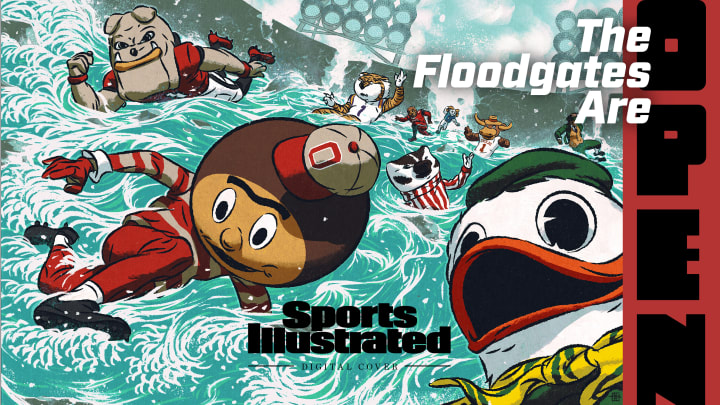The Floodgates Are Open as College Football Prepares for Unprecedented Sea Change
Mike McDaniel, Pat Forde, Patrick Andres, Tom Dierberger

The 2024–25 college football season is shaping up to be one of massive upheaval. The postseason field is tripling, Nick Saban is going over to the dark side, and everything we learned about geography in elementary school—we’re pretty sure California does not abut the Atlantic Ocean—is being blatantly disregarded in the name of expansion. These are the story lines to watch.
Expanded College Football Playoff
The 12-team College Football Playoff should have debuted in 2022. But a fractious, distrusting, often dysfunctional leadership group did what comes naturally—squabbling and overthinking it—for another couple of years before finally improving its postseason format. This will be worth the wait.
A sport that already is enjoying robust viewership and record revenue is about to find a next gear by adding eight teams to its playoff. The ingredients are there for something spectacular, with more postseason games that matter, more relevant regular-season games and more teams involved in the playoff chase. There will be first-round games at campus sites; a guaranteed spot for the highest-ranked team outside the power conferences; heavyweight quarterfinal matchups staged on traditional New Year’s Eve/Day dates at traditional locales; semifinals at the Cotton and Orange Bowls in early January; and a champion crowned on Jan. 20 in Atlanta.
During the four-team playoff decade, the list of contenders for those semifinals tended to whittle itself down to eight or fewer by Halloween. The vast majority of power-conference teams were eliminated, left to feign excitement over a bid to the ReliaQuest Bowl, while top players opted out. Now, the math says there will be three times as many (at least) the number of teams in contention and presumably three times as many games that will matter down the stretch.
With a 12-team playoff last year, virtually the entire AP Top 25 would have been in legitimate playoff contention heading into November. And the final rankings would have yielded on-campus playoff games at Florida State, Georgia, Ohio State and Oregon—rest assured, the top players on those star-studded teams would have stuck around to take part.
A common criticism of an expanded playoff system is that the regular-season games will lose some of their earth-shattering importance. Losses won’t carry the same payload they always have.
But on the flip side, champions of the power conferences in all likelihood will be rewarded with automatic berths and first-round byes, so the motivation to have a great regular season remains high. From September through November, the games will still matter. And then the 12-team brawl for a national title will be the best postseason the sport has ever seen.
—Pat Forde
Coaching Changes
College football has an opening for the game’s next dynastic leader. After 28 seasons as a collegiate head coach, including a historic 17-year run at Alabama, Saban announced his retirement in January. Instead of telling sideline reporters to “quit asking” or dropping one-liners like “a gnat on a cow’s ass” in his postgame news conferences, Saban will be on the other side of the microphone as an analyst on ESPN’s College GameDay.
But the Crimson Tide legend isn’t the only former national champion to move on. Jim Harbaugh, fresh off of leading his alma mater to a title, is back in the NFL with the Chargers. Jimbo Fisher, who guided Florida State to a title in the 2013 season, was fired by Texas A&M in November and is currently being paid handsomely ($7.2 million a year through ’31) to not coach.
That leaves just three active head coaches who have won a national championship: Kirby Smart (2021, ’22 with Georgia), Dabo Swinney (2016, ’18 with Clemson) and North Carolina’s Mack Brown (2005 with Texas).
Smart is the most logical choice to inherit Saban’s mantle.
Although Georgia was controversially left out of the CFP last season, it avenged that snub by destroying Florida State by 60 points in the Orange Bowl. The Dawgs have the top-ranked recruiting class incoming and are one of the favorites to win it all this season.
Swinney has something to prove at Clemson. The Tigers fell short of double-digit wins last year for the first time since 2010 and have watched as Pittsburgh and Florida State claimed the ACC title in two of the last three seasons, resulting in criticism toward Swinney for his inactivity in the transfer portal.
Elsewhere, former Washington coach Kalen DeBoer is tasked with keeping the machine rolling in Tuscaloosa as—until proven otherwise—Alabama will still be considered a power in the post-Saban years.
Texas coach Steve Sarkisian looks to be building something special in Austin. Dan Lanning is hoping Oregon makes some noise in the Big Ten, its new home. Ryan Day’s squads at Ohio State are always in the championship conversation late in the season.
Saban’s accomplishments at Bama—six national championships and nine SEC titles—likely won’t ever be topped. But the door is wide open for someone else to walk in.
—Tom Dierberger
Conference Realignment
One power conference lost 10 members and virtually ceased to exist. Four other leagues expanded. Gigantism is in, geography is out. Travel time is up … does fan interest follow?
The SEC scored the first and biggest acquisition, landing Big 12 bluebloods Texas and Oklahoma, and then stopped with 16 members. The Big Ten aggressively followed by gutting the Pac-12, annexing both Southern California (USC and UCLA) and the Pacific Northwest (Washington and Oregon), bloating to 18. The Big 12 swiped Colorado, Arizona, Arizona State and Utah to reach 16 schools. And the FOMO-afflicted ACC went bicoastal to grab Stanford and Cal, in addition to taking rich-and-desperate SMU to establish a Texas outpost. That league now has 17 ½ members, with Notre Dame maintaining friends-with-benefits relationship status.
All this realignment will result in many nonsensical things: Rutgers playing an 11 p.m. ET league game at USC on a Friday in October; Stanford and Cal making their ACC debuts at Syracuse and Florida State, respectively; West Virginia traveling to Tucson. Fans will lose regional rivalries and athletes will lose sleep.
But the new world order will produce many tantalizing matchups, such as USC at Michigan; Georgia at Texas; Washington at Penn State in November; and revived rivalries like Texas-Texas A&M and Oklahoma-Missouri.
While realignment has done a lot of damage, it has increased the number of high-interest conference games. There will be fewer dead weekends filled with unappetizing matchups, which is exactly what the TV networks wanted. Novelty, impactful games and resuscitated tradition sell, so those games should command massive ticket prices and ratings.
There will be a caveat emptor element to this, as several programs will lose at an unaccustomed and uncomfortable rate. The middle class of the SEC and Big Ten might particularly feel squeezed by the arrival of increased competition. Even the small triumph of a mediocre team winning, say, the Big Ten West will be lost as divisions are dissolved. Nobody hangs a banner for finishing seventh in an 18-team league.
There will be more conference losses but more quality conference games—and even more complaining about uneven schedules. But finishing third or fourth in a mega-league could have greater benefits than ever before with a 12-team playoff format.
The battle for bids will trickle down further in league ranks, which could transform disorienting November matchups like Nebraska-USC and Utah-Central Florida into something meaningful.
In the future, and perhaps not too distantly, conferences will continue to consume one another in the soulless search for more profit and power. But for now, settle into a new world in which Oregon and Maryland are conference rivals with absolutely nothing in common.
—Pat Forde
Pay for Play
The NCAA and the ACC, Big Ten, Big 12, SEC and Pac-12 agreed to a multibillion-dollar settlement in the House v. NCAA antitrust case in May, paving the way for schools to directly pay athletes for the first time in the history of major college athletics. The settlement agreement included a stipulation requiring the NCAA to pay over $2.7 billion in monetary damages to current athletes, as well as to past athletes dating back to 2016, for the revenue made off of their amateurism. There is also a revenue-sharing plan between the NCAA and respective power conferences that will see schools pay around $20 million per year to college athletes. This revenue-sharing plan will likely begin by ’25.
The bottom line: Amateurism is no more in major college athletics. Athletes have never been closer to being employees. Having players earn steady compensation from their schools will turn college athletics on its head. Add in the transfer portal and the ability for players to jump from school to school on an annual basis and you’re left with a landscape that resembles free agency in professional sports.
For college football specifically, television contracts have never been more lucrative. However, it remains to be seen how schools are going to be able to afford to pay players going forward. Will the payments for the best college football team a school can buy come at the expense of an institution’s other nonrevenue sports? What is the market value going to be for the best players at certain positions? How significantly will the “pay for play” era affect the competitive balance across conferences?
There are still plenty of questions, and answers will likely only come with time. However, this fall marks the beginning of a new era of college sports unlike anything we’ve seen before.
—Mike McDaniel
In-Helmet Communication
As much as college football has transformed in recent years, until 2023 it retained one crucial in-game element of its old-fashioned charm. No matter where in the country you watched a game or who was playing, you were bound to see coaches furiously signaling in plays by hand.
Those days are now gone. In April, the NCAA formally signed off on rules permitting one player on each side of the ball per team to receive communications from a coach via their helmet. The change puts college football at the FBS level in lockstep with the professional game (and even some high school jurisdictions).
“The intent is to get a little closer to what the NFL has done to allow communication,” Georgia coach and rules committee cochair Kirby Smart said in March. “It’ll allow communication with a quarterback and someone on defense, and we’ll find out where it takes us.”
The NFL has permitted one-way communication from the sidelines to the quarterback since 1994. (Defensive players got the technology in 2008.) As slow as college football was to adopt the practice, when teams were allowed to experiment with communication technology in bowl games this past season, its use drew rave reviews.
“It’s been a blast,” Texas Tech offensive coordinator and QB coach Zach Kittley said before the Red Raiders and Cal used the technology in the Independence Bowl last December, a game Tech won 34–14. “I love it. I think the NCAA needs to pass that rule, and I think it needs to be completely uniform across the NCAA.”
The allegations of orchestrating an elaborate multi-state scheme to steal opponents’ signals leveled against Michigan that may have helped precipitate the change suddenly seem quaint. We are living, for better or for worse, in a post–Connor Stalions world.
So goodbye, play cards adorned with NBA team logos and pictures of celebrities. Goodbye, coaches dressed like the Wiggles. Hello, radio. We’ll find out where it takes us, indeed.
—Patrick Andres
End of the Transfer Rule
In April, the Division I Council unanimously approved legislation allowing transfer college athletes to compete immediately at their new schools, regardless of whether or not they have transferred in the past. The groundbreaking rule change further accelerates the free agency era of college athletics, where athletes can transfer wherever and however many times they want, as long as they are in good academic standing.
The previous transfer rule allowed undergraduate college athletes to compete immediately if they were transferring programs for the first time. However, if they were transferring to a second school prior to graduation, they would be required to sit out for a year before competing again. With the new rule, college athletes are not limited in the number of times they can transfer, but in most cases, they can only enter the transfer portal in the two outlined windows of time per year for their respective sport. Exceptions to the transfer portal window are made for graduate transfers and for athletes when a head coach leaves a program. (As part of an agreement struck between the NCAA and the Department of Justice to settle an antitrust suit filed last year, athletes who have had to sit out a year since the 2019–20 academic year will get that season of eligibility restored.)
The new rule is loosely tied to academics, but heavily tied to the NIL culture that is driving so many significant changes across the college sports landscape. Now, programs across the country can compensate players under the guise of NIL without having to worry about whether or not the athletes would be eligible to compete immediately. The players now get the best of both worlds; they can jump from school to school on an annual basis, while getting paid to do it.
Loosened player transfer rules will make roster management more difficult than ever before, especially in major revenue sports such as football and men’s basketball.
But for the athletes, this is yet another significant victory in the era of player empowerment.
—Mike McDaniel


